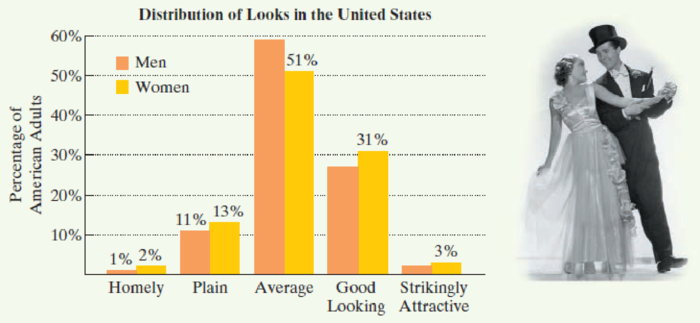
Concept explainers
Here’s Looking at You. According to University of Texas economist Daniel Hamermesh (Beauty Pays: Why Attractive People Are More Successful), strikingly attractive and good-looking men and women can expect to earn an average of $230,000 more in a lifetime than a person who is homely or plain. (Your author feels the need to start affirmative action for the beauty-bereft, consoled by the reality that looks are only one of many things that matter.) The bar graph shows the distribution of looks for American men and women, ranging from homely to strikingly attractive.

Source: Time, August 22, 2011
The percentage of average-looking men exceeds the percentage of strikingly attractive men by 57. The percentage of good-looking men exceeds the percentage of strikingly attractive men by 25. A total of 88% of American men range between average looking, good-looking, and strikingly attractive. Find the percentage of men who fall within each of these three categories of looks.
Trending nowThis is a popular solution!

Chapter 1 Solutions
COLLEGE ALGEBRA ESSEN.-MYLABMATH+ETEXT
- Make up two polynomial functions, f(x) and g(x). • f(x) should be of degree 3 or higher. g(x) should be of degree 4 or higher. • Find f(3) in each of the three ways: substitution, remainder theorem (synthetic division), and long division. You should get the same answer three times for f(3). Find g(-2) once using your choice of the three methods.arrow_forwardere are many real-world situations that exhibit exponential and logarithmic nctions. • Describe two real world scenarios, one exponential and one logarithmic. Do not identify yet whether your scenarios are logarithmic or exponential.arrow_forwardstacie is a resident at a medical facility you work at. You are asked to chart the amount of solid food that she consumes.For the noon meal today, she ate 1/2 of a 3 ounce serving of meatloaf, 3/4 of her 3 ounce serving of mashed potatoes, and 1/3 of her 2 ounce serving of green beans. Show in decimal form how many ounces of solid food that Stacie consumedarrow_forward
- I've been struggling with this because of how close the numbers are together!! I would really appreciate if someone could help me❤️arrow_forwardMatrix MЄ R4×4, as specified below, is an orthogonal matrix - thus, it fulfills MTM = I. M (ELES),- m2,1. We know also that all the six unknowns mr,c are non-negative with the exception of Your first task is to find the values of all the six unknowns. Think first, which of the mr,c you should find first. Next, consider a vector v = (-6, 0, 0, 8) T. What's the length of v, i.e., |v|? Using M as transformation matrix, map v onto w by w = Mv provide w with its numeric values. What's the length of w, especially when comparing it to the length of v? Finally, consider another vector p = ( 0, 0, 8, 6) T. What's the angle between v (from above) and p? Using M as transformation matrix, map p onto q by q = Mp - provide q with its numeric values. What's the angle between w and q, especially when comparing it to the angle between v and p?arrow_forward7. (a) (i) Express y=-x²-7x-15 in the form y = −(x+p)²+q. (ii) Hence, sketch the graph of y=-x²-7x-15. (b) (i) Express y = x² - 3x + 4 in the form y = (x − p)²+q. (ii) Hence, sketch the graph of y = x² - 3x + 4. 28 CHAPTER 1arrow_forward
- Part 1 and 2arrow_forwardWhat is the distance between 0,0 and 2,0 aarrow_forwardCompare the interest earned from #1 (where simple interest was used) to #5 (where compound interest was used). The principal, annual interest rate, and time were all the same; the only difference was that for #5, interest was compounded quarterly. Does the difference in interest earned make sense? Select one of the following statements. a. No, because more money should have been earned through simple interest than compound interest. b. Yes, because more money was earned through simple interest. For simple interest you earn interest on interest, not just on the amount of principal. c. No, because more money was earned through simple interest. For simple interest you earn interest on interest, not just on the amount of principal. d. Yes, because more money was earned when compounded quarterly. For compound interest you earn interest on interest, not just on the amount of principal.arrow_forward
 Algebra and Trigonometry (6th Edition)AlgebraISBN:9780134463216Author:Robert F. BlitzerPublisher:PEARSON
Algebra and Trigonometry (6th Edition)AlgebraISBN:9780134463216Author:Robert F. BlitzerPublisher:PEARSON Contemporary Abstract AlgebraAlgebraISBN:9781305657960Author:Joseph GallianPublisher:Cengage Learning
Contemporary Abstract AlgebraAlgebraISBN:9781305657960Author:Joseph GallianPublisher:Cengage Learning Linear Algebra: A Modern IntroductionAlgebraISBN:9781285463247Author:David PoolePublisher:Cengage Learning
Linear Algebra: A Modern IntroductionAlgebraISBN:9781285463247Author:David PoolePublisher:Cengage Learning Algebra And Trigonometry (11th Edition)AlgebraISBN:9780135163078Author:Michael SullivanPublisher:PEARSON
Algebra And Trigonometry (11th Edition)AlgebraISBN:9780135163078Author:Michael SullivanPublisher:PEARSON Introduction to Linear Algebra, Fifth EditionAlgebraISBN:9780980232776Author:Gilbert StrangPublisher:Wellesley-Cambridge Press
Introduction to Linear Algebra, Fifth EditionAlgebraISBN:9780980232776Author:Gilbert StrangPublisher:Wellesley-Cambridge Press College Algebra (Collegiate Math)AlgebraISBN:9780077836344Author:Julie Miller, Donna GerkenPublisher:McGraw-Hill Education
College Algebra (Collegiate Math)AlgebraISBN:9780077836344Author:Julie Miller, Donna GerkenPublisher:McGraw-Hill Education





